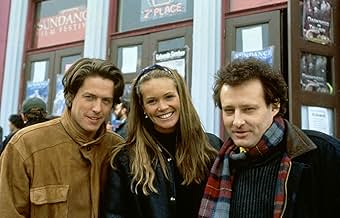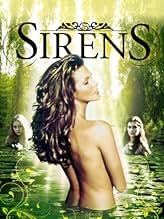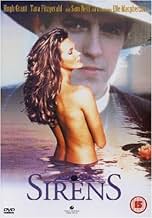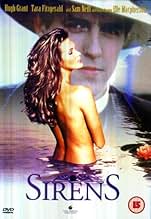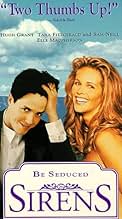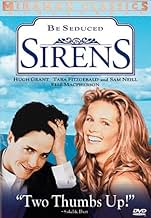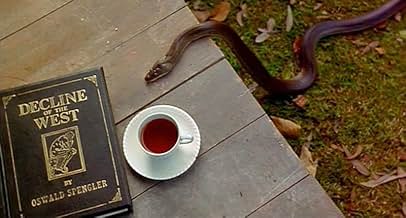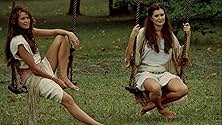VALUTAZIONE IMDb
5,9/10
11.980
LA TUA VALUTAZIONE
Quando un dipinto viene definito blasfemo, un giovane ministro e sua moglie visitano l'artista e le tre modelle sessualmente giocose che vivono con lui.Quando un dipinto viene definito blasfemo, un giovane ministro e sua moglie visitano l'artista e le tre modelle sessualmente giocose che vivono con lui.Quando un dipinto viene definito blasfemo, un giovane ministro e sua moglie visitano l'artista e le tre modelle sessualmente giocose che vivono con lui.
- Regia
- Sceneggiatura
- Star
- Premi
- 1 vittoria e 4 candidature totali
Tziporah Malkah
- Pru
- (as Kate Fischer)
Recensioni in evidenza
I never heard of this film until the director for our theater company mentioned it as a possible project to adapt to live theater. I have to say when I first viewed the film I was a bit shocked for personal reasons. We have a fairly small group and if taken directly it would mean I would be playing one of the nude models. After studying the film's critiques and background I slowly came around to appreciate the film's merits, if not completely comfortable with the nudity. The point is that the nudity is not suppose to be comfortable from the audience point of view. The story takes place in an almost mystical world untarnished by outside influences and taboos. It is indeed a wonderful Eden. As an actress I had to be comfortable within the Eden created on stage, despite being uncomfortable in front of fellow "actors" and the audience. This has become one of my favorite films for helping me grow as an actress and as a member of the audience.
While this film is often not taken seriously because of its explicit nudity, it is in fact one of the most thought-provoking commentaries on religious values I have ever seen on the screen. This film provides us with the stark contrast of the repressed preacher from London and the artist's three models in rural Australia, a throwback to Shakespeare's "Green World." The fulcrum of this contrast is the preacher's wife, being pulled in both the oppressive, "moral" direction by her upbringing and her husband and the free and expressive direction of the artist. The breathtaking cinematography and stunning visual symbolism of this film contribute to make it into a powerful attack on the Christian moral code that dominates western thinking. I have been scoffed at on more than one occasion for praising Sirens, but I left the theater questioning my own views about what is and is not moral. The fact that this film's sexual content seems to invalidate it as art in many people's eyes merely underscores the value of its message. Along with Sling Blade, Sirens to me stands as the most provocative film about morality made in the 1990's. A solid 8 on a scale of 1 to 10.
I absolutely love this truly erotic film. An exploration of the awakening of a woman's sexuality, it is beautifully filmed and acted, and has many moments of wit and humour.
Some reviewers object to the heavily laden symbolism attributed to various parts, such as the shots of the snake. Well, symbolism is part of what good writers refer to as "subtext", it isn't too often seen these days, and is at least part of an attempt to have the film say more than what the characters say to each other. This is an artistically valid thing for any film to do, and raises the level of film culture generally, if only a little.
I have yet to see anyone commenting on the superb score - this wonderful music by Rachel Portman (whose work I otherwise do not know) is a delight from start to finish, and unlike most movie music, would stand on its own as a concert piece. The main theme, quirky, cheerful and rhythmically very interesting, seems to take as its inspiration the Vaughan Williams "March of the Kitchen Utensils" heard at the very start of the film as we follow Hugh Grant's feet walking through the art gallery, but it is very much an excellent piece of music in its own right. The "Dream Variations" are suitably dreamy, and coupled with the slow motion photography make for a superb piece of cinema.
John Duigan (writer, director) is not often mentioned in the same breath as other well known Australian directors such as George Miller or Peter Weir or Bruce Beresford, but personally I think he stands up with the best of them. A true Auteur (he has scripted most of the films he has directed) his films are always very interesting character studies. A more well known recent film he made was "The Leading Man" which starred Jon Bon Jovi as an American actor who comes to London to appear in a West End Play, and is "hired" by the director to seduce his wife. As in The Leading Man, Sirens is about the interactions between characters, this providing in my view more than enough in the way of plot and sub-plot. If Duigan's films always seem to be about human sexuality, well, after all, that is what drives most human relationships, whether we want to admit it or not. I think what stands out about Duigan's films, and particularly about Sirens, is their total honesty about human sexuality, without (and I know some will disagree) being excessively prurient.
A final line - I love the helicopter shot at the very, very end of the film. It is a beautiful, painterly landscape scene (which fades out *just* too soon), but one's love of its beauty is strengthened by one's admiration of the five actresses, who had to climb to the top of this sheer-looking rocky outcrop and remove all their clothes for the shot! They have my appreciation, and my sympathy!
Some reviewers object to the heavily laden symbolism attributed to various parts, such as the shots of the snake. Well, symbolism is part of what good writers refer to as "subtext", it isn't too often seen these days, and is at least part of an attempt to have the film say more than what the characters say to each other. This is an artistically valid thing for any film to do, and raises the level of film culture generally, if only a little.
I have yet to see anyone commenting on the superb score - this wonderful music by Rachel Portman (whose work I otherwise do not know) is a delight from start to finish, and unlike most movie music, would stand on its own as a concert piece. The main theme, quirky, cheerful and rhythmically very interesting, seems to take as its inspiration the Vaughan Williams "March of the Kitchen Utensils" heard at the very start of the film as we follow Hugh Grant's feet walking through the art gallery, but it is very much an excellent piece of music in its own right. The "Dream Variations" are suitably dreamy, and coupled with the slow motion photography make for a superb piece of cinema.
John Duigan (writer, director) is not often mentioned in the same breath as other well known Australian directors such as George Miller or Peter Weir or Bruce Beresford, but personally I think he stands up with the best of them. A true Auteur (he has scripted most of the films he has directed) his films are always very interesting character studies. A more well known recent film he made was "The Leading Man" which starred Jon Bon Jovi as an American actor who comes to London to appear in a West End Play, and is "hired" by the director to seduce his wife. As in The Leading Man, Sirens is about the interactions between characters, this providing in my view more than enough in the way of plot and sub-plot. If Duigan's films always seem to be about human sexuality, well, after all, that is what drives most human relationships, whether we want to admit it or not. I think what stands out about Duigan's films, and particularly about Sirens, is their total honesty about human sexuality, without (and I know some will disagree) being excessively prurient.
A final line - I love the helicopter shot at the very, very end of the film. It is a beautiful, painterly landscape scene (which fades out *just* too soon), but one's love of its beauty is strengthened by one's admiration of the five actresses, who had to climb to the top of this sheer-looking rocky outcrop and remove all their clothes for the shot! They have my appreciation, and my sympathy!
Having lived through similar experiences while in my late 20's, early 30's I found the movie both entertaining as well as sensitive. I suppose there could have been more graphic scenes for those of a more shallow nature needing to see some models naked and doing more, but that was not necessary for my wife and I to enjoy it- having been there, we knew what was not pictured.
Men, like the Preacher, often fail to see the sensuous side of women, either that or it frightens them. They see "sex" when they should be seeing loving and caring. The movie illustrates that nicely. The two townsmen who come to visit the models are a clear example of sex versus loving and sensuality. The clueless type is the Preacher.
Men, like the Preacher, often fail to see the sensuous side of women, either that or it frightens them. They see "sex" when they should be seeing loving and caring. The movie illustrates that nicely. The two townsmen who come to visit the models are a clear example of sex versus loving and sensuality. The clueless type is the Preacher.
6=G=
"Sirens" (title refers to Homer's sirens) tells of a young church official who is dispatched to visit a painter at his remote Aussie studio/estate to dissuade him from showing a painting of a nude on a cross. Hugh Grant plays the minister who, with his wife, encounters four beautiful models (one is the artist's wife) who bemuse him with their nude romps and sensual ways. Moreover, he's distressed by his wife's apparent interest in the unabashed frolicking. "Sirens" is a not too serious and somewhat sensual film with a thin plot. The film's appeal is in the moment-to-moment situations, the shangrila "feel" given to the harsh outback locale, the feminist antics of the bevy of babes, etc. Some will find the film tedious while others will be captivated by it's subtle charms.
Lo sapevi?
- QuizAlthough this is a work of fiction, it is about a real person. Norman Lindsay was a real-life artist and author in Australia during the early 1900s. Several of his books have been adapted into movies, including Age of Consent (1969).
- BlooperThe beautiful green steam locomotive that is seen in an early scene is a NSWGR 38 class, which first entered service in 1942. ( the movie is set around the year 1930. )
- Citazioni
Sheela: [Anthony has just gone to the outhouse] I should have warned him about the redbacks.
Estella Campion: What are they?
Sheela: Small spiders with big teeth. They live under toilet seats usually.
Estella Campion: How do you know if they're there?
Sheela: By the screams.
- Curiosità sui creditiThe situations depicted in this film are fictitious and do not represent events in the lives of Rose, Norman, Jane and Honey Lindsay.
- Versioni alternativeAccording to the Technical Specifications link for this page on IMDB, there are two different versions of this film: "1 hr 38 min (98 min)," and "1 hr 34 min (94 min) (Canada)."
- ConnessioniEdited from A Steam Train Passes (1974)
- Colonne sonoreGrey Funnel Line
Written by Cyril Tawney
Dick James Music, Ltd.
Performed by Silly Sisters
Courtesy of Chrysalis Records, Ltd.
I più visti
Accedi per valutare e creare un elenco di titoli salvati per ottenere consigli personalizzati
- How long is Sirens?Powered by Alexa
Dettagli
- Data di uscita
- Paesi di origine
- Lingua
- Celebre anche come
- Sirenas
- Luoghi delle riprese
- Aziende produttrici
- Vedi altri crediti dell’azienda su IMDbPro
Botteghino
- Lordo Stati Uniti e Canada
- 7.770.731 USD
- Fine settimana di apertura Stati Uniti e Canada
- 34.299 USD
- 6 mar 1994
- Lordo in tutto il mondo
- 7.770.731 USD
Contribuisci a questa pagina
Suggerisci una modifica o aggiungi i contenuti mancanti


